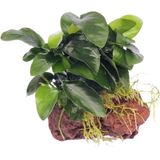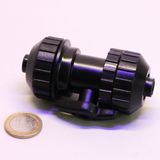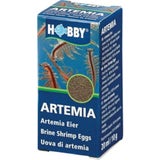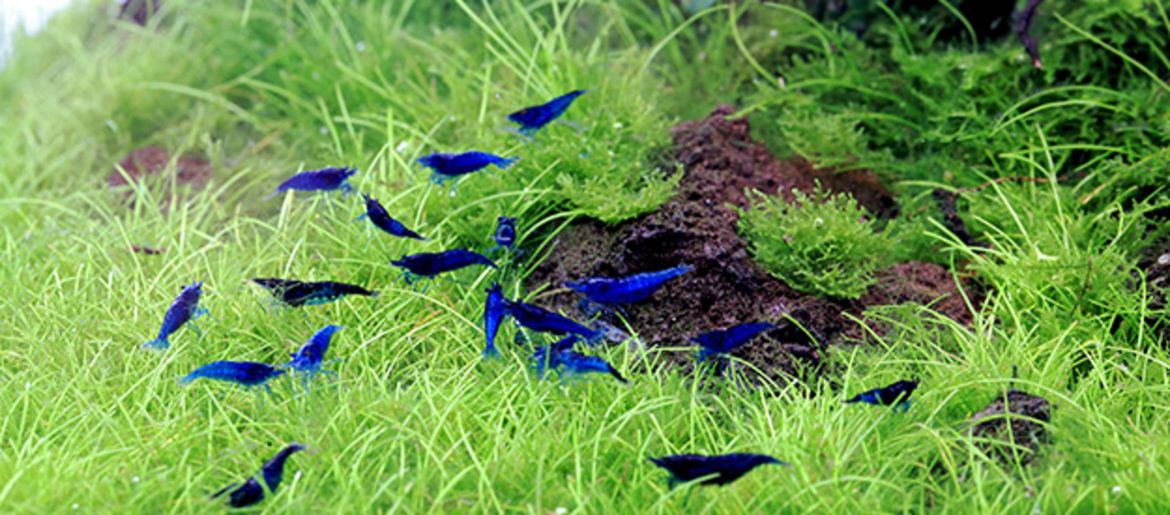Feed your shrimp properly
How do you feed your shrimp?
For the care of dwarf shrimp in the aquarium, the wildest feeding tips circulate, even spaghetti or bananas are occasionally recommended here - also things that almost never fall into the streams in the natural biotopes! If we want to know how to properly feed shrimp, we have to look at what they eat in their home. One quickly realizes that shrimp are not picky with leftovers and more or less really dig in to what they find - but they simply don't find many different things.
Most of the dwarf shrimp eat leaves in their streams, which fall off the trees and then end up in the water. Furthermore, of course, plants and plant remains. It cannot be ruled out that there is sometimes fruit in the stream - but rarely (usually the streams do not meander through orchards).
Then now and then insect larva, water snail or even a fallen animal (but also here - this happens really rarely and is definitely not part of the main diet). In addition to leaves, dwarf shrimps, in their very clean streams, mainly feed on the growth that forms on all surfaces. These biofilms consist of bacteria (excellent protein suppliers), algae, fungi, yeast and other microorganisms. They are high in protein and contain minerals - all in all quite substantial.
If you were to feed as much in the aquarium as it might happen in the stream (for example, if a larger fruit falls into the water), you would also quickly have a huge problem. In the stream, the shrimp has a water change of 100% every second, which is not really feasible in the aquarium, and the filter is definitely completely overwhelmed with such a sudden high nutrient load. This quickly leads to huge problems such as bacterial blooms and a lack of oxygen in the aquarium that has washed out. Your aquarium inhabitants can even die from it or it will make them sick.
You therefore feed shrimps in the aquarium rather sparingly. Your main food should mainly be based on plants. Protein-containing biofilms can also be found here everywhere, so that the shrimp can easily supply themselves with proteins in tanks that are not too heavily populated. There are indications that shrimp react with molting problems when their protein in their food is not optimally usable, so the protein intake should definitely not be exaggerated. Meat from mammals has no business in the shrimp aquarium. Shrimp do not have intestinal muscles, they just push the food through. So you need a certain amount to make digestion work smoothly, and it shouldn't be too substantial. So fibre is really very important to them. In order to boost the immune system of shrimp, ß-glucan is now a recognised agent - it occurs in the outer skin of many germs and signals increased awareness of the shrimp's immune system - a "hello-wake up" for the disease defense. If you buy shrimp feed, you should always make sure that it contains ß-glucan.
Shrimps can swim, but spend most of the time on the ground or on other surfaces in the aquarium. So it is quite important that the feed goes down straight away and does not remain in the area for a long time.
A good staple food for every day contains all the important nutrients and building materials that your shrimp want for healthy, not too fast, but also not too slow growth and good reproduction. With a good basic food such as the directly sinking ShrimpKing Complete from Dennerle, you can cover the needs of your dwarf shrimp very well. The proteins and essential amino acids in the Dennerle shrimp feed come from bacteria and aquatic feed animals, so they are well tolerated. Shrimp King uses various leaves and bark as a source of fibre, and algae and various vegetables serve as a source of vitamins. In order to boost the immune system of the shrimp, the feed developers have added a good portion of ß-glucan from yeast.
In principle you do not need anything other than this basic feed with a moderate shrimp stock. But who is sensible when it comes to favourites? The cute little crawlers are also happy about a treat - and here, pure vegetable nibbles such as the Crusta Spinach Stixx or the Crusta Nettle Stixx from Dennerle are best suited. Snacking with a guilty conscience is no longer a problem for your shrimp. You can also make them extremely happy with the vitamin-rich and mineral- containing nano algae food leaves (by the way, your racer snails in the aquarium, too). Shrimp King Snow Pops made from soy bran are not only tasty and healthy, they also offer you the opportunity to provide your shrimp with a good food for several days that they literally fly on. Since the high-quality, protein-rich and vital substance-containing soy bran hardly pollutes the water, you can even feed it here for two or three days. The pops form a feeding turf in which every shrimp comes to the feed. This avoids stress and makes the Snow Pops a real superfood for shrimp.
If your aquarium is more heavily populated, the shrimp may no longer find enough biofilms to feed on. Then you should specifically refill with compatible proteins twice a week so that your shrimp females still develop eggs and the egg quality is right. With the Shrimp King Protein food sticks for targeted nutritional supplements with high-quality proteins and essential amino acids, you will definitely not go wrong here. If your water is very low in minerals, you should supplement minerals with the shrimp feed - shrimp need a good portion of minerals for their shell! Shrimp King Mineral food sticks contain easily usable calcium for a stable tank structure and the all-rounder mineral montmorillonite, which can help with molting. ShrimpKing Mineral not only tastes good for your dwarf shrimps, it is ideal for feeding crayfish, dwarf crayfish, crabs and even snails - they also need calcium for their shell. With the most popular shrimps for the aquarium, the bee shrimp and their relatives, the smallest dwarfs are not really mobile. Bee shrimp babies are more or less always in one place during the first days of life. If there is no food there, bad luck! For this reason, an aquarium with baby shrimp is often given dust feed such as the Shrimp King Baby microgranules. It is distributed evenly in the pool, so that everyone gets their portion. If the larger shrimp catch something of it, it's not bad, the Shrimp King Baby is also a very good feed for them. While some people are still discussing coloured food, others are already looking forward to beautiful, colourful shrimps ... natural astanxanthines are also part of the daily food of shrimps in nature. These substances can not only colour, but they also play a very important role in the immune system of the shrimp! These natural colour enhancers are included in Shrimp King Color . Especially colourful shrimp species can give you a push in the right direction. What they cannot do - turn a transparent shrimp into a bright red shrimp. But nobody wants that either. And then we have the specialists among the shrimps - fan shrimps prefer to eat fine floating particles, which they filter out of the water with their fans. This is quite tricky in a clean aquarium, and so Dennerle has developed Shrimp King Atyopsis, a special dust food for these great animals. It also floats in the water for a long time and does not sink too quickly, so your Atya, Atyopsis and Atyoida fan shrimps are well looked after.
We hope you enjoy your new aquarium!
Chris Luckhaup
Latest reviews
-
 4.0 (3)
4.0 (3)Dennerle Plants Anubias nana on Stone
- Beautiful lava stone
- Covered in dark green
- Dimensions: 13 x 8 x 12 cm
€ 14,99Sold out
-
 € 12,99
€ 12,99Delivery by January 17
-
 4.9 (13)
4.9 (13)Hobby Artemia Eggs, 20 ml
- Always fresh live food
- Easy handling
- Promotes the splendour of colours and vitality of your fish
€ 6,99 (€ 349,50 / l)Delivery by January 07
-
 4.0 (4)
4.0 (4)Fluval Phosphate Remover, 106/107, 206/207
-5%- Effectively removes and controls phosphate.
- Prevents potential surges.
- Suitable for use in fresh or marine water
€ 5,69 € 5,99 (€ 19,62 / kg)Delivery by January 07
